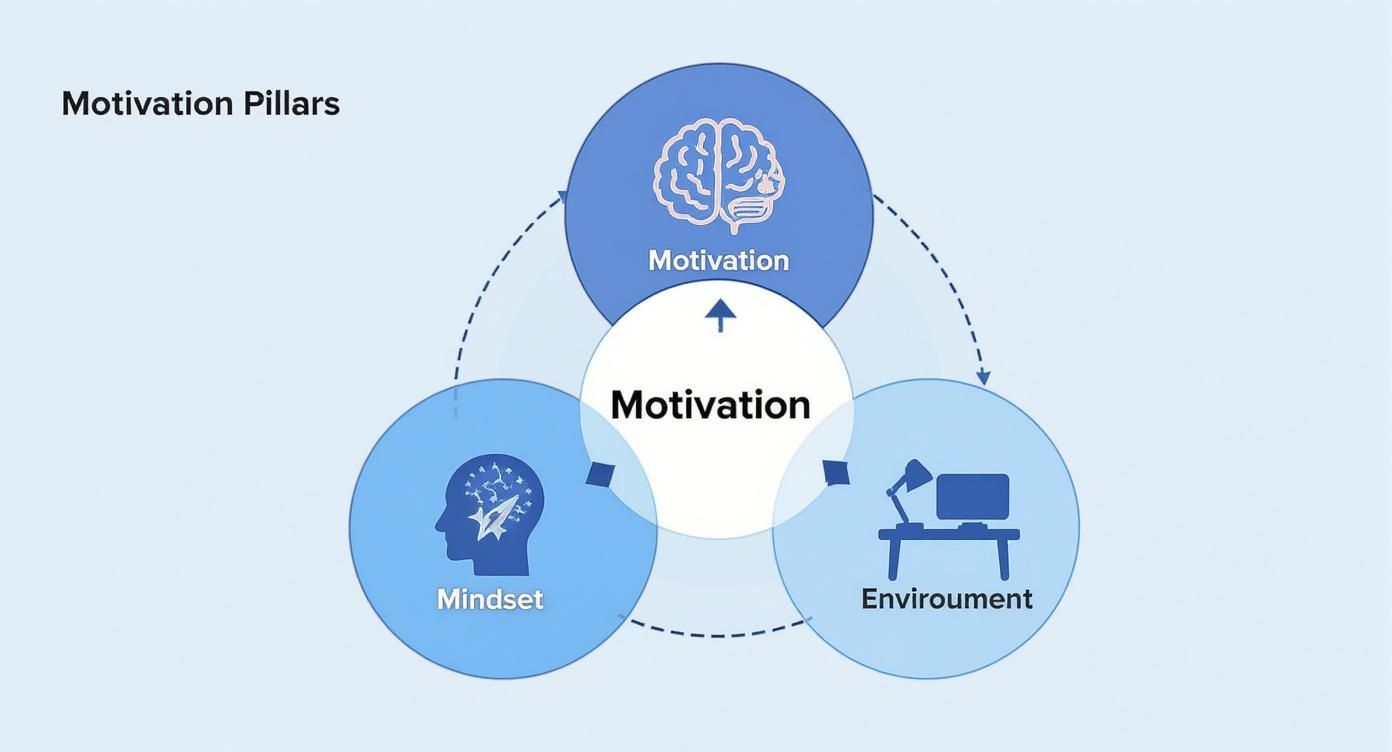Feeling like you're running on empty at work? You are not alone. That creeping sense of burnout is a challenge for millions, but it doesn't have to be your reality. Staying motivated is a skill you can build, not a feeling you have to wait for.
The truth is, sustained motivation is rare. A Gallup study found that only 21% of employees worldwide feel truly engaged at work. This isn't just a personal struggle; it translates into trillions in lost global productivity.
The problem isn't a lack of ambition. It's often a disconnect between our daily tasks and a deeper sense of purpose. Before we dive into solutions, it's powerful to understand why you might feel unmotivated in the first place. Identifying the root cause is the first step toward lasting change.
So, how do we reignite that fire? Think of motivation as a system built on three core pillars: your Purpose, your Mindset, and your Environment. When they work in harmony, they create unstoppable momentum.

As you can see, true motivation isn’t a switch you flip. It’s a powerful ecosystem you cultivate—one where purpose, mindset, and environment fuel each other.
Your Motivation Self-Assessment Checklist
Before we move forward, let's do a quick, honest check-in. This checklist will help you pinpoint exactly where your motivation might be hitting a roadblock. See which of these resonates with you.
| Symptom | Check If This Sounds Like You |
|---|---|
| The "Sunday Scaries" are intense. | ☐ The thought of Monday fills you with dread, not just the usual end-of-weekend blues. |
| Your to-do list feels overwhelming, not helpful. | ☐ Looking at your tasks creates paralysis, not productivity. Every item feels like a heavy weight. |
| You can't remember the last time you felt proud of your work. | ☐ You're going through the motions, and the deep satisfaction of a job well done feels distant. |
| Small setbacks feel like massive failures. | ☐ A minor mistake or critique derails your entire day, making it hard to regain your footing. |
| Your workspace feels draining. | ☐ Your desk, office, or digital setup feels cluttered, chaotic, or completely uninspiring. |
| You find yourself constantly procrastinating. | ☐ You're scrolling, snacking, or doing anything but the task at hand, even with deadlines approaching. |
If you see yourself in any of these, know that it's a sign—not of failure, but of an opportunity to intentionally build a system that supports your ambition.
Take Back Control of Your Drive
Forget the generic advice. The secret to lasting motivation is to stop seeing it as a fleeting emotion and start treating it as a skill you can strengthen every day.
It begins by honoring that feeling of being stuck. From there, you can pivot your focus to what you can control. You don't need a massive career change to feel a difference. It's about small, practical actions that compound over time.
"Motivation is overrated. Environment often matters more." - James Clear, Author of Atomic Habits
This insight from James Clear is transformative. It reminds us that creating the right conditions for success is far more effective than waiting for inspiration to strike. By focusing on your purpose, mindset, and environment, you build a system that fuels itself.
Let's dive into how you can start building that system today.
Connect Your Daily Tasks to Your Bigger Why
Let's be real: lasting motivation rarely comes from a paycheck or a deadline. That kind of drive is temporary. The motivation that truly endures is fueled by purpose—the electrifying feeling that your work contributes to something bigger than a to-do list.
When you can draw a clear line from your daily tasks to a meaningful outcome, even the most mundane chores gain significance.
This isn’t about finding a grand, abstract "passion." It's a practical exercise in reframing your perspective. How does your role support the company's mission? Does your work help a customer solve a real-world problem? Do your administrative tasks empower your team to create something incredible?
Consistently aligning your daily efforts with bigger goals is a learnable skill. Exploring powerful executive function strategies can help you forge this connection until it becomes second nature.
Find Your Personal Connection
While the company mission is a great start, your personal "why" is the ultimate powerhouse. Your job is more than a job; it’s a vehicle for your life’s ambitions.
Action Point: Define your "why." Ask yourself:
- Skill Development: What skills am I building here that will serve my five-year plan?
- Financial Goals: How is this role helping me save for a house, support my family, or fund a passion project?
- Networking: Who am I meeting today that could open doors for me tomorrow?
When you consciously link your work to these personal goals, everything changes. You’re no longer just working for the company; you are investing in your own future.
A Real-World Example in Action
Imagine a project manager at a startup, drowning in meetings, spreadsheets, and status reports. On the surface, it’s a recipe for burnout.
But she reframed her "why."
Instead of seeing her work as just "managing projects," she adopted a new focus: "I build tools that help small businesses thrive."
This simple shift changed everything. A follow-up email wasn't nagging; it was ensuring a small business owner got a critical feature on time. A budget spreadsheet wasn't a chore; it was the financial map guiding her team's innovation.
She connected her daily actions to the success of real people, and her motivation soared. Your work has an impact. Your mission is to find that connection and remind yourself of it, every single day.
Build Mental Resilience with Simple Mindset Shifts
Your mindset is the engine of your motivation. Like any engine, it needs regular maintenance to run smoothly. Building mental resilience doesn’t require hour-long meditation sessions; it’s about weaving tiny, powerful habits into your day.
These aren't just feel-good tricks. They are small, consistent actions, grounded in neuroscience, that rewire your brain for a more positive and resilient outlook. Consistency, not intensity, is the key. A few dedicated minutes for a mental reset can completely alter your day’s trajectory, keeping you centered amid the chaos.

Practice the Two-Minute Mental Reset
Feeling like your brain has too many tabs open? That's the perfect time for a reset. The Two-Minute Mental Reset is a simple mindfulness technique with profound effects.
Action Point: Try this right now.
- Find a quiet spot. Simply turn your chair away from your screen.
- Set a timer for two minutes. A defined endpoint makes it feel effortless.
- Focus on your breath. Breathe in, breathe out. When your mind wanders (and it will), gently guide it back to your breath.
This acts as a circuit breaker for your stress response, clearing your mental slate so you can approach your next task with a calm, fresh perspective.
Tap Into the Power of Small Wins
Our brains are hardwired to thrive on progress. The Progress Principle, a concept from Harvard researchers Teresa Amabile and Steven Kramer, shows that making even minor headway on meaningful work is a powerful motivator.
It’s not about the champagne moment after a huge project. It’s about acknowledging the small victories—sending that tough email, solving a tricky problem, or helping a colleague.
Action Point: Start a "Win Jar."
At the end of each day, take 60 seconds to write down one thing you accomplished on a small piece of paper and put it in a jar. This simple act reinforces your capability and provides tangible proof that you are moving forward, fueling your long-term drive.
Create Your Own Path for Professional Growth
Feeling stuck is one of the fastest motivation killers. When the path forward is unclear, it's easy to slip into autopilot.
Don't wait for your manager to design your career path. The key to staying fired up is to become the architect of your own professional journey.
This is where you stop waiting and start creating. You don't need a new title to grow. By committing to continuous learning, you build your own momentum and take control of your career narrative.
Proactively Hunt for Growth Opportunities
Where do you begin? Start with honest self-reflection.
What one or two skills would make you more impactful in your role right now? What abilities would prepare you for the job you want next?
Action Point: Create a micro-development plan.
- Valuable Online Courses: Platforms like LinkedIn Learning or Coursera offer expert-led courses on almost any skill imaginable.
- Find a Mentor: Identify someone whose career you admire and ask for a 30-minute virtual coffee. A single conversation can provide incredible clarity.
- Volunteer for Stretch Projects: Look for internal projects just outside your comfort zone. Raising your hand shows initiative and provides invaluable on-the-job learning.
This proactive stance is incredibly empowering. Research consistently shows that opportunities for development are a top driver of employee motivation. Even if your company lacks a formal program, taking this initiative yourself fulfills that same deep-seated need. You can see the full analysis of what motivates employees to understand just how crucial this is.
Growth Opportunities Inside and Outside Your Role
| Growth Strategy | Best For | Action Step |
|---|---|---|
| Shadowing a Colleague | Understanding a different role or department. | Ask to sit in on a team meeting or observe a specific task for an hour. |
| Industry Certifications | Gaining specialized, recognized credentials. | Research certifications in your field (e.g., PMP for project managers) and start a course. |
| Leading a Team Initiative | Developing leadership and project management skills. | Propose a small project to improve a team process and offer to lead it. |
| Attending a Webinar | Quickly learning about new trends or tools. | Find a free, relevant webinar and block out the time on your calendar. |
| Mentoring a Junior Employee | Reinforcing your own knowledge and leadership. | Offer to help a new hire get up to speed or answer their questions. |
| Joining a Professional Group | Networking and learning from peers outside your company. | Look for local or online industry groups on LinkedIn and join the conversation. |
Document and Share Your Progress
As you acquire new skills, keep a "brag file"—a running document of your accomplishments.
Finished a certification? Write it down. Successfully led a project? Add it to the list.
This isn’t about ego; it’s about recognizing your growth. It taps into the Progress Principle, giving you a powerful motivational boost. Plus, during your next performance review, you’ll have a concrete list of achievements, proving you're ready for the next challenge.
Design an Environment That Inspires You
Your workspace profoundly affects your mood and focus. A dull, cluttered desk can silently drain your energy, while an intentional space can pull you into a state of flow.
Let's move beyond just tidying up. The magic happens when you consciously design a space—both physical and digital—that serves as a launchpad for your best work. These small, strategic shifts can revolutionize your daily drive.
Curate Your Physical Workspace
Think of your desk as your command center. Environmental psychology tells us that a few tweaks can make a massive difference. First, maximize natural light—it's a proven mood and energy booster.
Action Point: Personalize your space with purpose.
- Photos: A picture of family, a pet, or a favorite place can anchor you on a tough day.
- Inspirational Quotes: Find a quote that genuinely resonates and place it in your line of sight.
- A Healthy Plant: A touch of green is proven to reduce stress and spark creativity.
These are not mere decorations; they are visual cues connecting you to your "why." An organized desk is a great foundation, and you can explore the benefits of a tidy work and home environment to build from there.
"Motivation is overrated. Environment often matters more."
This idea from James Clear is a game-changer. When your environment supports your goals, productivity becomes the path of least resistance.
Perform a Digital Declutter
Your digital workspace is just as critical. A chaotic desktop, a flooded inbox, and constant notifications create cognitive overload, making focus impossible.
Action Point: Take 15 minutes for a digital refresh.
- Clean Your Desktop: Drag all files into a single "To Sort" folder. Only pull out what's essential for today.
- Organize Your Browser: Use bookmark folders for your most-visited sites, like "Work Projects," "News," or "Inspiration."
- Turn Off Non-Essential Notifications: Be ruthless. Silence anything that doesn't demand an immediate response.
By reducing digital noise, you reclaim your mental energy and can pour your focus into the work that truly matters.
Set Healthy Boundaries to Protect Your Energy
Constant availability is the enemy of motivation. When work bleeds into every corner of your life, your energy plummets, leaving you drained and uninspired.
Protecting your time isn't about working less; it's about working smarter, so you can show up focused, engaged, and ready to create your best work.
This 'always-on' culture is a widespread issue. A recent workforce survey revealed that only 19% of full-time office employees truly want to be there, largely due to a culture that erodes personal time. It’s a stark reminder that boundaries are essential for long-term career fulfillment. You can discover more insights about these workplace trends from Korn Ferry.

Communicate Your Availability Clearly
First, define your working hours—and then communicate them. Your colleagues cannot respect boundaries they don't know exist.
Action Point: Signal your availability.
- Update your status: Use Slack or Teams to signal your focus. "Deep work until 2 PM" or "Signing off for the day" are clear and effective.
- Use your email signature: Add a simple line: "My working hours are 9 AM to 5 PM. I will respond to messages outside these times on the next business day."
This small shift puts you back in control of your schedule. For more guidance, our post on how to set healthy boundaries offers more practical steps.
Learn to Say 'No' Gracefully
Politely declining requests that derail your priorities is a superpower. Saying "no" doesn't make you unhelpful; it makes you strategic.
A "no" to one thing is a "yes" to something more important—your well-being, your key projects, or your family.
Action Point: Have scripts ready.
- "My plate is full right now, but I can take a look at this next week."
- "I’m not the best person for this, but have you tried asking [Colleague's Name]?"
Setting these limits preserves your energy for what truly matters and teaches others to respect your time—an absolute essential for staying motivated long-term.
Let's Tackle Some Common Motivation Questions
Even with a solid plan, staying inspired can be tough. Certain hurdles are universal. Let's address some of the most common motivation blockers and how to overcome them.

What If I Dislike My Job but Can't Leave?
This is a challenging position that many people face. When your role isn't a source of joy, the key is to shift focus to what you can control.
Embrace "job crafting"—making small changes to your role to better align it with your strengths and interests. Could you volunteer for a project that genuinely excites you? Can you frame your daily tasks as opportunities to build specific skills for your next career move? This mental shift transforms your narrative from "I'm stuck" to "I'm strategically building my future."
How Do I Handle a Demotivating Boss or Colleague?
One negative person can drain the energy from an entire team. The best defense is to create psychological distance.
Consciously limit non-essential interactions and pour your energy into your own work and goals.
"You can't control the actions of others, but you can control your reaction to them."
Double down on your "why." Celebrate your own small wins. Build alliances with positive, supportive colleagues. Their negativity is their burden to carry, not yours.
What Should I Do When My Motivation Just… Dips?
Motivation is not a constant state; it's a wave. It ebbs and flows for everyone. The goal isn't to be motivated 100% of the time, but to have a plan for when it dips.
When you feel your drive fading, return to the basics:
- Reconnect with your "why." Take sixty seconds to review your long-term goals.
- Take a real break. Step away from the screen, walk outside, and give your brain a true reset.
- Knock out one tiny task. Answer one email. Organize one folder. A small completion creates a burst of momentum you can build on.
See these dips as a normal part of the process, not a personal failing. With a go-to plan, you can ride out the low points without letting them derail you.
Continue your journey of inspiration and mindfulness with Mesmos. Our thoughtfully designed products are here to remind you of your purpose and bring beauty into your daily grind. Explore our collection and find your new source of motivation.
